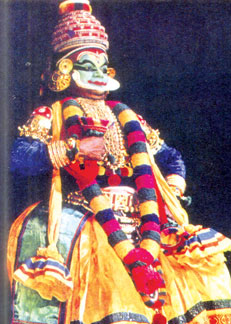Kathakali, the embodiment of Indian theatre
by Gwen Herat
|

Karunakaran in the role of the great Hindu God, Lord Krishna
from the popular epic
Mahabharatha. |
Derived from two Indian words Katha which means story and Kathak
meaning story-teller and though different from Kathak, Kathakali is one
of the four main dance styles of India in the classical repertoire. It
is known for the heavily mime-oriented dance drama that has become the
embodiment of Indian theatre. It comes from Malabar in the extreme coast
of South India and achieved perfection over 300 years ago.
Kathakali combines the traditions of the ancient rituals of pre-Aryan
origin with the forms of mime, drama as they have been registered in the
Natyashastra, merging as a perfectly integrated art form that includes
dance, drama, singing and instrumental music with a very refined,
complicated and highly stylised vocabulary of gestures.
Masks and heavy make-up play a very important role and the various
characters wear masks of different colours.
It takes over five hours to make up a single face. The stories are
extracted from mythology and history.
Performances take place in the courtyard of a temple or on a platform
outside, after dusk and will last a whole night.
The dancers are so passionate of Kathakali that they feel they dance
their history.
Legends
Many of India's fabulous legends and ancient mythology are
reincarnated today by Kathakali and classical dance drama of the country
that is rich in culture and tradition. The dancers display epic heroes,
incarnate gods, divine sages and demons portray timeless tales of good
and evil and the three words, Heaven, Earth and Hell.
There is a strong religious element with most Eastern dancing. Many
of the dances are performed in temples and religious places or in the
presence of royalty. Even today most of the performances in Kerala are
given specially constructed stages in the temples but are inaccessible
to non-Hindus.
The special feature is the application of make-up that transforms
dancers to gods and demons and the appropriate and elaborate costumes,
layers and layers of it in much weight, is perhaps the reason that
Kathakali is confined to men. The brilliant jewellery that set off the
massive costumes are combined with weird and towering head-dresses which
make dancers a strange sight to the Western eye.
Physical demands
|

Four dancers from the Kerala Kalamandalan group in the roles
they appear in various legends. From left, Sivasankaran as
Arjuna, Karunakaran as Lord Krishna, Sivaraman as Damayanthi
and Padamanashan as Shiva, disguised as a hunter. |
Like in Shakespeare's era when women's roles were acted by young men,
Kathakali too follow suit, because of the exacting physical demands
needed in this form of dancing.
Apart from the training they are given in dancing, an important part
of it is the eye movement training. It is strange but true that 15
minutes of eye movement has to be worked out by the dancers before any
performance.
Some of the classics danced by Kathakali dancers are Mahabharatha,
Nala Charita, Bhagavadghitha, Sons of Pandu and Ramayana.
Nala Damayanthi, a production of Chitrasena-Vajira is an adaptation
of Nala Chitra. I too danced in this epic when I was a schoolgirl and
studying Kandyan dancing under them. In Nala Charita, the role of
Damayanthi is danced by Shivaraman (a male dancer). The ballet was from
an original mounted by the Kerala Kalamandalam Kathakali Dance Company.
Strange as it may sound, there are shades of Swan Lake in Nala
Damayanthi.
Similarity
There is a similarity between Kandyan dancing and Kathakali in
movements, costumes as well as make-up. As much as girls shun Kathakali
the same applies in Kandyan dance when girls evade anything similar to
this form of art which is found in some Vannams and low country dance
and choreographed especially to those of boundless energy.
Of the four dance schools of India Kathak, Kathakali, Bharath Natyam
and Manipuri, it is Kathakali that upholds the country's traditions,
diverse religions and history.
Their dance today, is what they danced 500 years ago.
The glorious art's repertoire is mostly found in the archives of
Malabar preserved in the sanctity of Lord Krishna, Lord Siva and the
lesser known gods in Indian mythology. |


